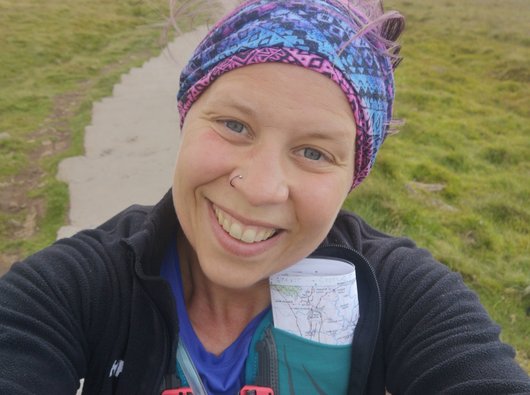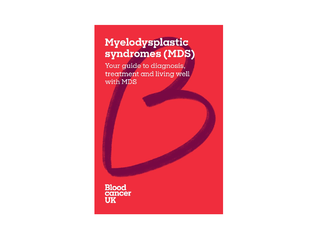Myelodysplastic syndromes (MDS) intensive treatment
Intensive treatment for MDS usually means having intensive chemotherapy followed by a stem cell transplant. The aim is to get rid of the MDS, so your bone marrow can work normally again.
Will I have intensive treatment?
Intensive treatment can be tough on the body and cause a lot of side effects. So your doctor will only recommend it if they think you are fit enough to cope with the treatment, and the benefits outweigh the risks.
Intensive chemotherapy
Intensive chemotherapy is a treatment option for some people with high risk MDS. The aim is to kill as many of the abnormal cells in the bone marrow as possible. It’s often used to get your body ready for a stem cell transplant, although a small number of people with MDS have intensive chemotherapy on its own.
Intensive chemotherapy can sometimes put people into remission. This means there are no signs of MDS when samples of your bone marrow are looked at under a microscope. Usually the remission is temporary, and without further treatment the MDS eventually comes back. For this reason, your doctor will usually offer you intensive chemotherapy followed by a stem cell transplant. This gives the best chance of the MDS being cured.
What to expect during intensive chemotherapy
This is what usually happens when you have intensive chemotherapy:
- You’ll have one or more cycles of intensive chemotherapy. Each cycle is made up of about 5-10 days of treatment, followed by 3 or more weeks for your healthy blood cells to grow back.
- The chemotherapy drugs are usually given as a liquid into a vein. To make it easier to give the treatment, you may have a long thin tube inserted into one of the veins in your arm (a PICC line) or chest (Hickman line). This can stay in for the whole treatment plan.
- You’ll usually need to stay in hospital during the treatment and while your blood cells recover. At some hospitals, you may be able to have chemotherapy as an outpatient. This is usually from the second cycle of treatment onwards.
- You’ll have blood tests every day while you’re in hospital to check how well the treatment is working.
- When your healthy blood cells have recovered, you’ll have tests to check if you’re in remission. Once you’re in remission, you may go on to have a stem cell transplant.
- If you’re not having a stem cell transplant, you may have more chemotherapy to keep you in remission for as long as possible.
Which chemotherapy drugs will I have?
The chemotherapy drugs you have will depend on your age and fitness, the type of MDS you have and whether you are having chemotherapy as part of a clinical trial. Your hospital team can explain which chemotherapy drugs they are planning to use for your treatment.
Drugs used for intensive chemotherapy include:
- Cytarabine and daunorubicin – these are the most common chemotherapy drugs used for high risk MDS.
- FLAG-Ida – This is a combination of three chemotherapy drugs – fludarabine, cytarabine and idarubicin. This combination is stronger than cytarabine and daunorubicin, and may be given to people who are younger and fitter.
"I’d take so much stuff into hospital with me, I think the nurses thought I was absolutely bonkers, bringing a yoga mat with me while having chemotherapy! But it was really important to me to keep moving as long as I felt well enough."
Emma, diagnosed with MDS in 2011.
Read Emma's tips for coping with long stays in hospital.

Stem cell transplant
A stem cell transplant gives the best chance of curing MDS. The type of stem cell transplant used for people with MDS is called an allogeneic transplant. It replaces the stem cells in your bone marrow with healthy stem cells from someone else (a donor).
A stem cell transplant is an intensive treatment that can have serious complications. So they are only recommended for people who are fit enough to go through the treatment, and when the benefits outweigh the risks.
What does a stem cell transplant involve?
If you have a stem cell transplant, you’ll need to be in hospital for at least 6 weeks.
Before your body is ready to receive the donor stem cells, you need to have treatment called conditioning.
There are 2 different levels of conditioning:
- full intensity (myeloablative) conditioning – this involves high doses of chemotherapy. Rarely, some people also have radiotherapy to the whole body (total body irradiation). The aim is to destroy your bone marrow and immune system.
- reduced intensity conditioning – this involves fewer or lower doses of chemotherapy. If radiotherapy is used, this is also at lower doses. The aim is to weaken your immune system enough to allow the donor stem cells to grow in your bone marrow. As it’s less intense, it can be a good option for people who are older and have other health conditions.
After conditioning, the new stem cells are given to you into a vein, in a similar way to having chemotherapy. Once in your bloodstream, they travel to your bone marrow and begin growing into new blood cells.
The stem cells usually come from either a family member or an unrelated donor. The donor needs to have a similar ‘tissue type’ to you. This means their genes are similar to yours. The more similar they are, the closer the match.
Our booklet, Blood stem cell and bone marrow transplants: the seven steps explains what happens before, during and after a stem cell transplant.

Order your free MDS booklet
Read about how to cope during treatment and live well with MDS in our free booklet.
